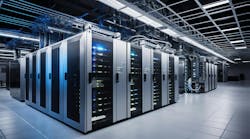While news such as the development of new data centers, the signing of new power purchase agreements, and the expansion of primary data center locations into areas that were once considered the edge has grabbed the lion’s share of media coverage, the expansion of colocation providers in the U.S. has seen much less attention.
Which, given the demand for space, especially with new facilities of any size being snapped up by hyperscalers with long-term contracts, makes it a market that deserves far more attention.
The existing buildings that are being snapped up via acquisition aren’t in one particular region or sized to serve the same markets, but spread across the country and with capacities from under a megawatt to close to 20 times larger.
If anything, this demonstrates the range of services that colocation facilities are in demand for, as business customers look for places to expand their often hybrid IT models.
Cologix
Cologix, with over 40 data centers in North America, has a focus on providing their customers with colocation space, cloud on-ramp services, network-neutral interconnections and data centers, and edge services with connections to the hyperscalers.
Their most recent expansion was through the acquisition of two data centers in the Des Moines, Iowa market announced in June. The two facilities were acquired from Connect Des Moines, LLC, renamed DSM1 and DSM 2, have been integrated into the existing Cologix portfolio.
The DSM1 facility is located in downtown Des Moines in the Financial Center Building, and is a 600 kW facility with 4000 square feet of space. Expansion is possible with a growth capacity of 10,000 square feet and 1 MW of power. The facility offers connectivity 26 networks via the Cologix Meet-Me-Room.
The DSM2 facility is located in the Cedar Falls area, roughly 100 miles northeast of Des Moines, and is a larger space. The DSM2 data center is a digital edge facility and offers 12,500 square feet and 1 MW of available power. Connectity to DSM1 and its services is via a diverse fiber ring. The data center has an additional 10,000 square feet available for future expansion.
Cologix also signaled their plans for future development in the region with the signing of a purchase agreement for additional land in the Des Moines area.
RadiusDC
RadiusDC, an edge data center operator focusing on interconnection and edge services development in urban areas, acquired the Miami1 data center from NextStream Datacenters, a colocation provider with nine data centers in Latin America.
With 170,000 square feet of space, the Miami1 data center has the potential to become a significant presence in the south Florida market. Located in Sweetwater, the two-story building was built to withstand Category Five hurricane winds, is carrier neutral, and currently offers connectivity options to Europe and South America via 11 fiber-optic and network services.
The facility is designed to support more than 15 MW of critical IT power, and at purchase is currently offering 3.9 MW of power to its customers. The new owners have announced plans to increase the available critical IT power capacity to 9.2 MW, along with increasing available connectivity options. The initial phase of this expansion is expected to be completed in the first half of 2026.
US Signal
US Signal, a data center operator and provider of digital infrastructure solutions, operates nine data centers in the midwestern U.S. Their most recent acquisition is their Detroit North data center in Auburn Hills, Michigan. This marks the fourth data center for US Signal in Michigan and their third facility in the metro Detroit region.
Their newest acquisition has 76,000 square feet of space with a 17,000 square foot raised floor section that can be expanded as necessary. There is currently 4 MW of critical IT power available which can be expanded to 8 MW.
Design goals were to serve the HPC and AI data center markets and the current plan is to make significant enhancements to this facility. The changes include plans to meet Tier III data center standards, an increase to 5 MW of available power, and 24/7 staffing.
To meet the expected demand, there is a plan in place to increase staffing, add additional office space, and add a 6-mile fiber build around the newly acquired facility to improve connectivity and networking options for clients.
US Signal highlights the fact that its data centers and services are audited for compliance with HIPAA/HITECH, PCI DSS, SOC 1, TYPE 2, and SOC 2, Type 1 and certified under the EU-US Privacy Shield Framework and Swiss-US Privacy Shield Framework.
Tierpoint
With more than 40 current data centers in the continental U.S., Tierpoint has taken a different approach in expanding their footprint in the St. Louis region, where they already have three current data centers. They have acquired a building in downtown St. Louis that they plan to convert into an enterprise grade data center.
While the building has over 135,000 square feet of available space, the first phase of the development calls for 22,600 square feet of data center space, with 3 MW of critical IT power available.
Eventually, Tierpoint plans to build out additional data center space in the building supporting up to 13 MW of critical IT load. This expands on the over 47,000 square feet of data center space that Tierpoint currently operates across its three existing St. Louis data centers. All of Tierpoint’s St. Louis data centers are currently connected to their nationwide 100G network infrastructure.
With plans to invest as much as $150 million in the facility Tierpoint has announced that a Fortune 100 company has signed on as anchor tenant for the new build.
What the Future Holds
These four companies, and their acquisitions and announcements since June of this year, highlight the constant growth happening at what used to be considered the edge of the data center market. With the continued expansion by hyperscalers in nearby regions, this segment is rapidly moving to the mainstream of data center development.






